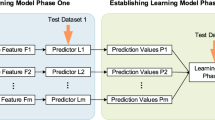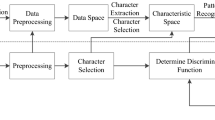Abstract
With the continuous development of civil aviation industry in recent years, the demand for flight training has been increasing and the flight training safety requirements have been improving. To address the problem that the mining of flight training data is not deep enough and the research of flight training data is delayed, the study proposes a flight training data prediction model based on incremental learning to achieve real-time flight training data prediction and ensure flight training safety. The model firstly uses a small amount of data to generate a base model; secondly, on this base model, a specific amount of data is input to the model for learning according to a certain time frequency to continuously optimize the base model; finally, the model is compared with several models for experiments. The experimental results show that compared with the traditional model, the model has high prediction accuracy and good real-time performance in flight training data prediction, which can better ensure flight training safety.



















Similar content being viewed by others
References
Janic M (2000) An assessment of risk and safety in civil aviation. J Air Transp Manag 6(1):43–50
Jensen RS (1982) Pilot judgment: Training and evaluation. Human Factors 24(1):61–73. https://doi.org/10.1177/001872088202400107
Qin, H, Wang, H, Xie, J, Tang, Y, Li, P. (2021) Development of flight data recorder for general aviation aircraft with real time data transmission, 162–167 https://doi.org/10.1109/ICCASIT53235.2021.9633449
Huo L, Jia S, Lu Y.U, Cai H. (2018) A flight parameter data real-time transmission and processing system. Modern Electronics Technique
Jia, S, Huo, L, Cai, H, Ge, J. (2015) Real time transmission system of aircraft flight data. Ordnance Industry Automation
Qiang C (2018) Research on a real time flight monitoring system for transport aircraft based on air ground wireless broadband com-munication technology. Inf Syst Eng 3:2
Wibisono, Jatmiko, Wisesa, HA, Hardjono, Mursanto (2016)Traffic big data prediction and visualization using fast incremental model trees-drift detection (fimt-dd). KNOWL-BASED SYST
Gijsberts A, Metta, G. (2013) 2013 Special Issue: Real-time Model Learning Using Incremental Sparse Spectrum Gaussian Process Regression. 2013 Special Issue: Real-time model learning using Incremental Sparse Spectrum Gaussian Process Regression, ???
F. Castño, R.M.d.T. R. E. Haber, Beruvides, G. (2014) Application of hybrid incremental modeling for predicting surface roughness in micromachining processes
Gepperth, A.,Hammer, B. (2016) Incremental learning algorithms and applications, Bruges, Belgium https://hal.archives-ouvertes.fr/hal-01418129
Wibisono, Jatmiko, Wisesa, HA, Hardjono, Mursanto (2016)Traffic big data prediction and visualization using fast incremental model trees-drift detection (fimt-dd). KNOWL-BASED SYST
Losing V, Hammer B, Wersing H (2018) Incremental on-line learning: A review and comparison of state of the art algorithms. Neurocomputing 275:1261–1274. https://doi.org/10.1109/ICCASIT53235.2021.9633449
Incremental on-line learning (2018) A review and comparison of state of the art algorithms. Neurocomputing 275:1261–1274. https://doi.org/10.1016/j.neucom.2017.06.084
He, J, Mao, R, Shao, Z, Zhu, F. (2020) Incremental learning in online scenario. In: Proceedings of the IEEE/CVF Conference on Computer Vision and Pattern Recognition (CVPR)
Ma, T, Xiang, G, Shi, Y. (2020) Horizontal in situ stresses prediction using a cnn-bilstm-attention hybrid neural network. Geomech. Geophys. Geo-energ. Geo-resour (8) https://doi.org/10.1007/s40948-022-00467-2
Cai Y, Guo J, Tang Z (2022) An eemd-cnn-bilstm-attention neural network for mixed frequency stock return forecasting. J Intell Fuzzy Syst 43(1):1399–1415. https://doi.org/10.3233/JIFS-213276
Siami-Namini, S, Tavakoli, N, Namin, A.S. (2019) The performance of lstm and bilstm in forecasting time series. In: 2019 IEEE International Conference on Big Data (Big Data), pp. 3285–3292 https://doi.org/10.1109/BigData47090.2019.9005997
Rusul, L. Abduljabbar, P.-W.T. Hussein Dia (2021) "unidirectional and bidirectional lstm models for short-term traffic prediction" 2021,16 https://doi.org/10.1155/2021/5589075
Liu, Y.-X, Chen, T, Li, D, Fu, J, Liu, S.-J. (2022) imeta: Integrated meta-omics for biology and environments. iMeta 1(1), 15 https://doi.org/10.1002/imt2.15
Tsotsos JK, Culhane SM, Kei Wai WY, Lai Y, Davis N, Nuflo F (1995) Modeling visual attention via selective tuning. Artificial Intelligence 78(1):507–545. https://doi.org/10.1016/0004-3702(95)00025-9. Special Volume on Computer Vision
Chen S, Ge L (2019) Exploring the attention mechanism in lstm-based hong kong stock price movement prediction. Quantitative Finance 19(9):1507–1515. https://doi.org/10.1080/14697688.2019.1622287
Funding
This research was supported by the Key Laboratory Research Project of Flight Technology and Flight Safety of Civil Aviation of China, Grant No. [FZ2020ZZ02]; the Safety Capabil-ity Project of Civil Aviation Administration of China, Grant No. [14002600100020J103]; and the Key Research and Development Project of Sichuan Province, China, Grant No. [2022YFG0027]. These funds will help further research on flight training safety issues and ensure flight training safety.
Author information
Authors and Affiliations
Contributions
Conceptualization, Y.S. and Z.R.; methodology, Y.S.; validation, Z.R.; formal analysis, Y.Z.; re-sources, J.U.; data curation, Y.B., J.D.PF; writing-original draft preparation, J.U.; writ-ing-review and editing, Y.S.; visualization, Z.R.; supervision, J.U.; project administration, J.U.; funding acquisition, J.U. All authors have read and agreed to the published version of the man-uscript.
Corresponding author
Ethics declarations
Conflicts of interest
The authors declare no conflict of interest.
Additional information
Publisher's Note
Springer Nature remains neutral with regard to jurisdictional claims in published maps and institutional affiliations.
Rights and permissions
Springer Nature or its licensor (e.g. a society or other partner) holds exclusive rights to this article under a publishing agreement with the author(s) or other rightsholder(s); author self-archiving of the accepted manuscript version of this article is solely governed by the terms of such publishing agreement and applicable law.
About this article
Cite this article
Lu, J., Shi, Y., Ren, Z. et al. Research on flight training prediction based on incremental online learning. Appl Intell 53, 25662–25677 (2023). https://doi.org/10.1007/s10489-023-04930-9
Accepted:
Published:
Issue Date:
DOI: https://doi.org/10.1007/s10489-023-04930-9




